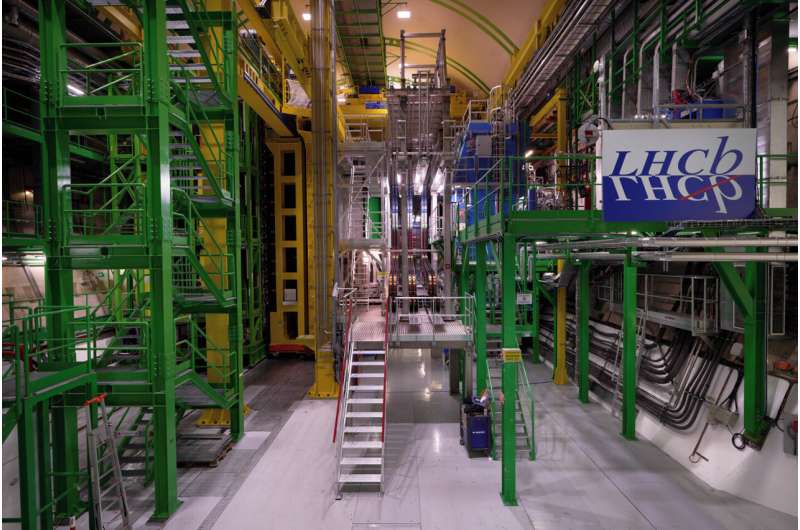This article has been reviewed according to Science X's editorial process and policies. Editors have highlighted the following attributes while ensuring the content's credibility:
fact-checked
preprint
trusted source
proofread
LHCb investigates the properties of one of physics' most puzzling particles

χc1(3872) is an intriguing particle. It was first discovered over 20 years ago in B+ meson decays by the BELLE collaboration, KEK, Japan. Since then, the LHCb collaboration reported it in 2010 and has measured some of its properties. But here's the catch—physicists still don't know what it is actually made up of.
In the quark model of particle physics, there are baryons (made up of three quarks), mesons (made up of a quark–antiquark pair) and exotic particles (made up of an unconventional number of quarks). To find out what χc1(3872) consists of, physicists must measure its properties, such as its mass or quantum number.
Theories suggest that χc1(3872) could be a conventional charmonium state, made up of charm and anticharm quarks, or an exotic particle composed of four quarks. An exotic particle of this type could be a tightly bound tetraquark, a molecular state, a cc-gluon hybrid state, a vector glueball or a mixture of different possibilities.
Previously, the LHCb collaboration has found its quantum number to be 1++ and, in 2020, made precise measurements of the width (lifetime) and mass of the particle. The collaboration also measured what is known as its low-energy scattering parameters. The results showed that its mass is just a tad smaller than the sum of the masses of the D0 and D*0 mesons.
Following these results, the theoretical community was divided. Some argued that χc1(3872) was a molecular state consisting of spatially separated D0 and D*0 mesons. This molecular state would be much larger than the typical size of particles and more comparable to a heavy nucleus.
However, this argument encounters a problem, namely that physicists expect molecular objects to be suppressed in hadron–hadron collisions, and the χc1(3872) is produced abundantly. Other theorists interpreted the results as clear evidence that χc1(3872) has a "compact" component. This would mean it is a particle with much smaller size, containing either a tightly bound charmonium or a tetraquark.
One way to help determine what χc1(3872) contains is to calculate the ratio between probabilities of the decays into different lighter particles (branching fractions).
By comparing the rate at which it decays either to an excited charmonium state or to a charmonium state and a photon, physicists can gather clues as to what type of particle it is. There is a clear theoretical signature: if the ratio is non-vanishing, it is evidence for some compact component in χc1(3872), disfavoring the pure molecular model.
Now, using the complete set of LHC Run 1 and Run 2 data, the LHCb collaboration has found these ratios to be non-vanishing, with a significance exceeding six standard deviations. The paper is available on the arXiv preprint server.
The large measured value of the ratios is inconsistent with the expectations based on the pure D0D*0 molecular hypothesis for the χc1(3872) particle.
Instead, it supports a wide range of predictions based on other hypotheses of the χc1(3872) structure, including conventional (compact) charmonium, a compact tetraquark containing a charm quark, charm antiquark, light quark and light antiquark, or a mixture of molecules with a substantial compact core component. In short, the result provides a strong argument in favor of the χc1(3872) structure containing a compact component.
The χc1(3872) particle continues to fascinate the particle physics community.
More information: R. Aaij et al, Probing the nature of the χc1(3872) state using radiative decays, arXiv (2024). DOI: 10.48550/arxiv.2406.17006
Journal information: arXiv
Provided by CERN





















